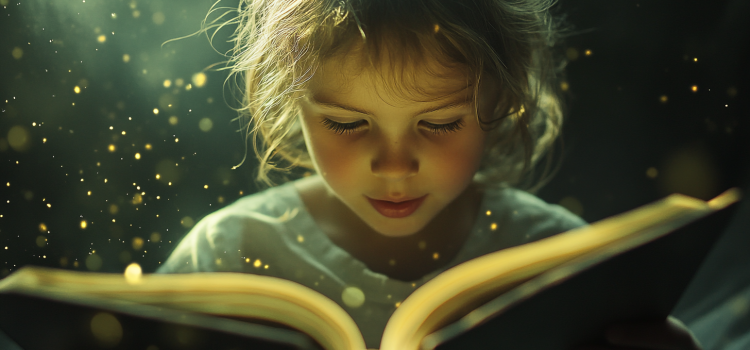
How do children learn to read? Why does the journey to becoming a fluent reader take years?
Cognitive neuroscientist Maryanne Wolf explores how children learn to read by tracing development from infancy through adolescence. From recognizing speech sounds as babies to mastering complex metaphors as teenagers, children build reading skills through distinct phases.
Read more to explore the fascinating science behind how a child transforms from a babbling toddler into a capable reader.
How Children Learn to Read
How do children learn to read? Today, each child undertakes a years-long journey to literacy. Neurotypical children, or those with the thinking and learning skills that society expects, go through several stages of development.
First comes infancy. Before a child encounters any written material, they hear words spoken aloud and read to them. During these early experiences, children develop essential foundations: understanding that pictures represent real things, learning that marks on a page carry meaning, and building basic vocabulary and language skills that will later support reading.
(Shortform note: Children may start developing the foundations for reading even earlier. Research shows that fetuses can hear external sounds as early as 27 weeks old and that they’re able to hear and recognize their mothers’ distinct voices and speech. For instance, they start distinguishing between different speech sounds even before birth. Fetuses also become familiar with the rhythm and intonational patterns of their native language(s), which is why newborns prefer to listen to their mothers’ language(s) over other languages. This early language exposure creates neural pathways that later support reading development.)
From ages one to five, children continue to develop key abilities that underpin reading and writing. Immersed in her native language(s), a child will keep learning the speech sounds and vocabulary she needs to hear and speak—imagine a toddler moving from babbling to trying for words, like “mom” or “dad.” Through being read to, she’ll also start to develop an awareness of letters and their names. Ideally, she’ll also learn to follow along with stories.
(Shortform note: Other experts distinguish year-to-year milestones in children’s speech and language development. During each year from ages one to age five—year one to two, two to three, and so on—children gain new skills. These range from understanding and acquiring simple words (between ages one and two), using two- to three-word phrases (ages two to three), and being able to name letters (ages four to five). Also from ages four to five, typically developing children can follow along with and tell simple stories.)
From ages five through seven, most children start or have already started reading. The emerging young reader will understand that letters represent sounds, and she’ll start to sound out words based on that insight. As she gets better at this, she’ll begin connecting simple words (like “but,” “and,” or “was”) to meanings and memorizing those connections.
(Shortform note: While Wolf describes the basic process of learning to read, there’s ongoing debate about how best to teach it. The “science of reading” movement argues that systematic phonics instruction—explicitly teaching letter-sound relationships—is crucial during these early years. This contrasts with “balanced literacy” approaches that emphasize learning words through context and exposure to literature, instead of through explicit phonics lessons. Both approaches have research backing them: For instance, one analysis found that children taught with systematic phonics had better outcomes than those taught with balanced literacy, while other studies show phonics works best when it’s taught as part of a balanced literacy program.)
At seven to nine years old, neurotypical children become more fluent readers. Continuing to grow and learn, the young reader can recognize more and more words automatically, which increases how fast she can read. She also comprehends more of what she reads, understanding not just the meanings of words but also what they mean when taken together in larger and larger chunks (paragraphs, chapters, books). And as she reads more, she expands her vocabulary, too.
(Shortform note: One thing that can help young readers become fluent is to read across different genres of writing. Different genres teach different skills and expose children to varied ways of using words and communicating meaning. For instance, fiction strengthens narrative comprehension and emotional understanding, while nonfiction teaches subject-specific words and ideas. Beyond this, reading across genres helps children become more aware of how diverse the world is by exposing them to a variety of perspectives and sensibilities. It also helps them make interdisciplinary connections, and often leads to finding types of books they genuinely enjoy.)
During later childhood, children begin to read with greater ease. Having memorized enough words to follow and enjoy what she reads, the young reader begins to grasp the multiple possible meanings of words in different contexts (like how “fly” can mean the bug or what that bug does to zip around in the air, and “zip” can describe that bug’s motion or what you do to close your pants).
(Shortform note: Children who grow up in bilingual environments may be better at navigating ambiguities like the multiple meanings of a word. One study of Greek-Albanian bilingual children ages 10 to 12 found that whether they understood words with multiple meanings depended on several factors: how frequently they encountered each meaning, the context surrounding each word, and the size of their working memory (how many words and meanings they could keep in mind). Children who could read and write in both languages were better at dealing with ambiguous words.)
Throughout adolescence and beyond, readers develop more advanced cognitive and critical thinking skills. By this point, the reader learns to recognize literary devices, like metaphor and irony. She’ll also form increasingly sophisticated personal connections to what she reads—like seeing her own qualities in a protagonist, recognizing lessons from a book that she’s experienced in her own life, or developing preferences for different styles and genres of writing.
(Shortform note: These more advanced literacy skills might come in part from “Theory of Mind” (ToM)—our ability to understand others’ mental states, beliefs, and intentions. At around 15 to 16 years old, teenagers’ ToM abilities get much stronger. This could help explain why teenagers better understand literary devices like unreliable narrators, complex character motivations, and subtle forms of irony. For example, a nine-year-old might struggle to understand why in The Catcher in the Rye, the protagonist says one thing but means another. But a teenager’s more developed Theory of Mind helps them recognize and understand this unreliable narrator.)
Throughout these stages, reading actively shapes the reader’s brain. As the child reads and grows, her brain develops increasingly sophisticated circuits for processing written language. Eventually, she becomes a fluent, literate, adult reader.
However, Wolf emphasizes that this development isn’t automatic—it requires the right conditions and support. Children need exposure to books, explicit instruction in reading skills, and opportunities to practice. Environmental factors like poverty or limited access to books can make it much harder for children to learn to read, and this can have a devastating effect: Some children hear millions fewer words than their peers by age five, and this can slow their growth as readers for years.
(Shortform note: Wolf bases her argument on an oft-cited study that found that children from lower socioeconomic classes hear 30 million fewer words by age three. However, more recent research suggests this gap is overstated. For one, a 2017 study that involved nearly eight times more families than the original 1992 research found a gap of only four million words by age four. Other studies have failed to replicate the original findings (and replicability is a mark of strong research). Also, some researchers have shown that language exposure varies dramatically across communities in ways that aren’t straightforwardly tied to income. Wolf is still right that we should support young readers—but the solution may not be as simple as compensating for disparities in words heard in childhood.)






